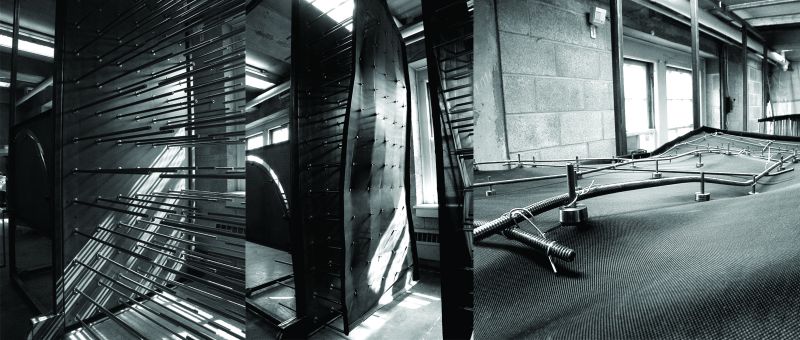Miguel Lantigua
Spring 2013
--
The inauguration of concrete casting through
rigid formwork techniques in itself radically altered the construction
industry, consequently a large sum of the architecture produced, especially in
the latter half of the 19th and early 20th century since the
rediscovery of concrete. Indeed the adaptation of this building material inevitable
attributed to the proliferation of concrete architecture. Despite its revolutionary
break through, techniques in formwork construction had not remained natural. Fabric
formwork, which one can argue as the second most critical phase of the material’s
development, is a building technique which deploys the use of structural membranes,
that is, fabric, as a means to generate concrete components through the molding
process. Yet while such transition/ method of formwork drastically alters the
image and possibilities in the use of concrete, what remains consistent between
rigid and the flexibility that is fabric formwork is its fast production, economics,
and manipulation opportunities. However, it is critical to not fancy formwork techniques
‘merely’ per its economic qualities, rather what makes this method of construction
so appealing is the opportunity to use the plasticity of concrete, which in the
case of fabric formwork, is enhanced in possibilities made by the inherent
properties of fabric, to generate dynamic forms and spaces previously unconceivable
and achievable in rigid formwork techniques.
Fabric formwork finally allows us to ‘further’
apply conceptual architectural approaches, particularly those which deal with more
relatable spaces, by allowing concrete to be as free as it truly is, that is,
its ability to take any shape, rather than be confided to rigid boarders which
lake the reliability to us, specifically the complexity that is our bodies. In
a nutshell, formwork in general should not be deployed on the mere basis of its
fast pace economic qualities. More than this, ‘fabric’ formworks unlike the
limitations of metal, wood, and brick construction, which are rigid components,
allows us to contribute to how we generate space through reinventing how ways
of producing both conceptual and structural systems.
The following projects, accompanied with
links, are in support of the above argument, in fact, deploying the very
conceptual and structural notions mentioned. Please do look into this further
and learn of the space and conceptual possibilities made possible by fabric formworks:
Note: Image captions are of the project's author
--
This first project inspired by Eadward Muybridge, explores the role of the human body in the formation of space through the use of concrete fabric formworks, that is, first recording the movement of bodies in space.
Excerpt: : The idea of physically recording the movements of a body within a space spawned a series of photographic studies using motion-capture photography pioneered by Eadward Muybridge. Combining these methods with more recent digital technology helped record and map how the body occupies an interstitial space. The actions of sleeping, walking and sitting within a defined space were recorded in plan and elevation with a camera. Combining the individual frames into a composite image manifested the ghost of the space once occupied by the body.
 |
| Program sequence of interstitial space in plan |
 |
| Flexible fabric formwork mechanism |

 |
| Internal walkthrough of the defined interstitial space |

Output of concrete panels created by the machine
This second project asks the question of: what
a beam and column could become. A beam needn’t be joined to a column as two
individual pieces, could they be cast as a single element using sewing to
stitch and shape the formwork using sleeves?
In which they explored the possiblities of: a more rational form might result if each element was cast together as
a single entity using the qualities of the fabric to dicate the form. Our joint
was made in the formwork itself.
Project link: http://richardbush.wordpress.com/




Video: http://vimeo.com/53981192

No comments:
Post a Comment